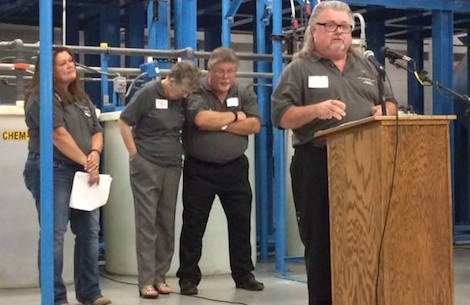Burton Metal Finishing Rebuilds After Fire
2013 fire took Burton almost two years to get things built back up.

Burton Metal Finishing in Columbus, Ohio, is back in the swing of things after rebuilding following a 2013 fire at their plant. Last summer, Burton held their grand re-opening at their rebuilt facility, and is now growing faster than ever.
The fire occured Oct. 4, 2013, and it took Burton almost two years to get things built back up.
Burton Metal Finishing has been family-owned and operated since their beginning in 1987. They offer decades of industry experience and provide exceptional customer service. Their father, Dallas Burton, founded the company to meet the metal finishing needs of customers in the greater Columbus area.
When the new plant re-opened, the new features are an automated and computerized control system that checks each part as it progresses though the line. Other improvements to their quality control operations are the addition of an x-ray machine and implementing Skype video communication for customer interaction. The company says the new video communication will save time and money by allowing customers to visually examine a part before it completes quality inspection.
Each aspect of their new facility has been carefully planned to modernize our operations and facilitate excellence in the finished product they deliver to customers, the owners say.




Related Content
-
NASF/AESF Foundation Research Project #122: Electrochemical Approaches to Treatment of PFAS in Plating Wastewater - 12th Quarterly Report
This NASF-AESF Foundation research project report covers the 12th quarter of project work (October – December 2023) at the University of Georgia. In our previous report, we described our work on performance and effect of surface fluorinated Ti4O7 anodes on PFAS degradation in reactive electrochemical membrane (REM) mode. This quarter, our experiments involved utilizing porous Ti4O7 plates serving both as anodes and membranes. Tests compared pristine and F-18.6 Ti4O7 anodes at current densities of 10 mA/cm2 and 40 mA/cm2. This 12th quarterly report discusses the mechanisms of the effects on EO performance by anode surface fluorination.
-
NASF/AESF Foundation Research Project #120: Electrochemical Destruction of Perfluorooctanesulfonate in Electroplating Wastewaters – January – December 2023
This NASF-AESF Foundation research project report covers quarterly reporting for the year 2023 at the University of Illinois at Chicago. The objective of this work is to utilize a cost-effective reactive electrochemical membrane (REM) for the removal of PFAS from synthetic electroplating wastewater. Discussed here are the oxidation of PFOA with three different catalysts, development of a method for detecting PFAS, as well as work on 6:2-fluorotelomersulfonic acid (6:2 FTS) and electrodeposited bismuth/tin oxide catalysts.
-
Ultrafiltration Membranes, Filter Elements for Improved Industrial Water Reuse
Ultrafiltration membranes help with water reuse in a variety of applications.










.jpg;maxWidth=300;quality=90)



